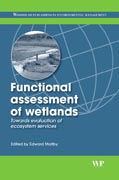
Wetlands perform functions that deliver benefits to society, often referred to as ecosystem services. These ecosystem services include water supply, flood regulation, water purification, climate regulation, biodiversity, agriculture (e.g. grazing land), and amenity. A functional approach to wetland assessment enables a holistic view to be taken of the wide range of services wetlands canprovide. The functional assessment procedures (FAPs) in this volume translatebest available scientific knowledge into reasonable predictions of how component parts of wetlands function in different landscape contexts. They can be used to indicate the potential and priorities for management options in such areas as flood control, pollution reduction and biodiversity conservation. Functional assessment enables the user to predict the functioning of a wetland areawithout the need for comprehensive and expensive empirical research The FAPs therefore provide a methodology that can be used by both experts and non-experts to assess wetland functioning relatively rapidly. The volume includes an electronic version of the FAPs on CD which automates aspects of the assessment once the initial recording stage is completed. It is anticipated that the FAPs will be used by a range of individuals or organisations concerned with wetlandmanagement who wish to gain a better understanding of the processes, functions, services or benefits and potential of the wetlands for which they have responsibility. INDICE; SECTION 1 INTRODUCTION Introduction to wetlands and functional assessment - Introduction - What is a wetland? - The importance of the wetland resource - Realising the benefits of wetland functioning - Threats and impacts on the wetland resource - Challenges for the future of wetlands and their management - What is a functional approach? - Introduction to the functional analysis procedures (FAPs) - The Functional Assessment Procedures CD-ROM - The application of functional analysis - Further reading and references SECTION 2 WETLAND DATABASE ESTABLISHMENT Introduction - Objectives - Method - Output from database establishment - Data recording and references - Further reading and references Fieldwork preparation - Introduction - Assessment Area (AA) delineationand map preparation - Contributory Area (CA) delineation and map preparation - Collection of desk information on assessment area (AA) and contributory area(CA) - Confirmation of rights of access - Selection of required field equipment - Further reading and references Hydrogeomorphic (HGMU) delineation - Introduction - Check and enhance prepared assessment area AA MAPS - Subdivide AA into its main components - Subdivide AA landscape components into HGMUs: preparation and procedure - Further reading and references HGMU Characterisation - Introduction - Recording of geomorphic indicators - Recording of hydrological indicators - Recording of ecological indicators - Habitat and vegetation identification - Part 1: land-use and site management, field indicators - Part 2: collection of HGMU information - Assignment of hydrological codes - Estimation ofHGMU area - Nutrient input characterisation - Trace element input characterisation - Further reading and references Recording sheets - Recording sheet 1 - Recording sheet 2a - Recording sheet 2b - Recording sheet 2c - Recording sheet2d - Recording sheet 2e - Recording sheet 3 - Recording sheet 4 SECTION 3 FUNCTIONAL ASSESSMENT Introduction - Method - The syntax for combinations of answers in look-up tables - An example of how to use the assessment charts - Further reading and references Hydrological functions - Introduction - Floodwater Detention (function) - Groundwater Rrecharge (function) - Groundwater Discharge(function) - Sediment Retention (function) - Rapid quantification of hydrological function - Further reading and references Biogeochemical functioning - Introduction - Nutrient Retention (water quality function) - Nutrient Export (water quality function) - In situ Carbon Retention (function) - Trace Element Storage (function) - Trace Element Export (function) - Organic Carbon Concentration Control (function) Ecological functioning - Introduction - Ecosystem Maintenance (function) - Food Web Support (function) SECTION 4 SCORING AND APPENDICES Functional analysis summary - Functional Analysis Summary Table - When the functional assessments have been carried out - Ecosystem services - References- Scoring the functions: Hydrological functions, Biogeochemical functions, Ecological functions Appendix 1 Glossary and alternative terminology - Glossary - Glossary of scientific terms - Alternative terminology Appendix 2 Information sources (United Kingdom) Appendix 3 Reference list for codes Appendix 4 Publications and theses produced during FAPs development Appendix 5 Conversion of process outcomes to functional scores - electronic version - Hydrological functions - Biogeochemical functions - Ecological functions
- ISBN: 978-1-85573-834-8
- Editorial: WOODHEAD PUBLISHING LIMITED
- Encuadernacion: Cartoné
- Páginas: 712
- Fecha Publicación: 01/05/2009
- Nº Volúmenes: 1
- Idioma: Inglés
